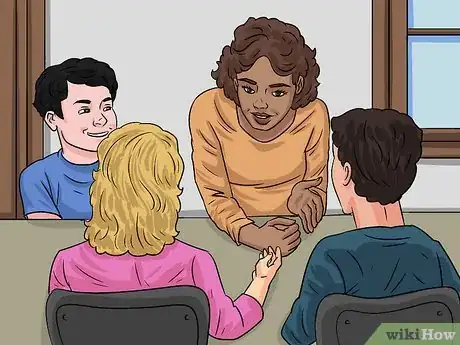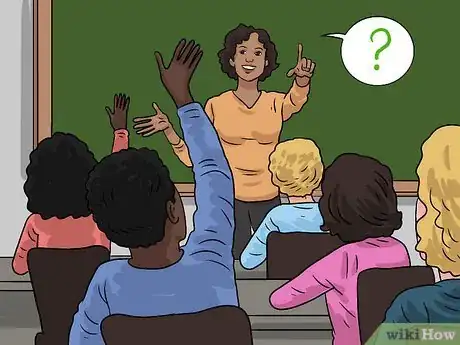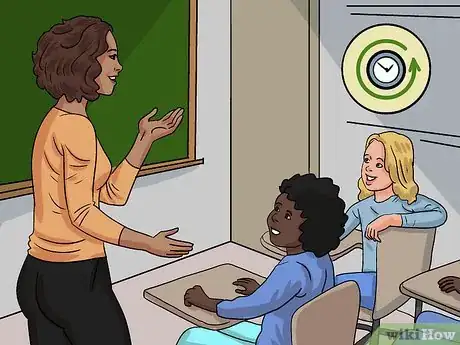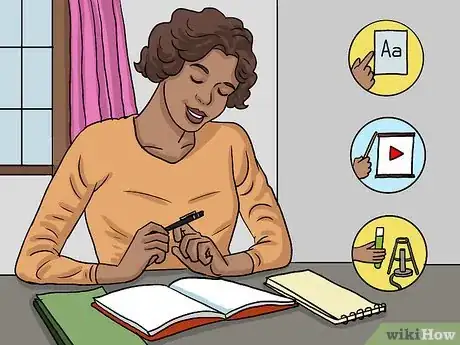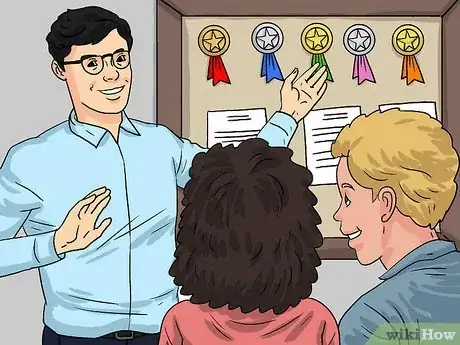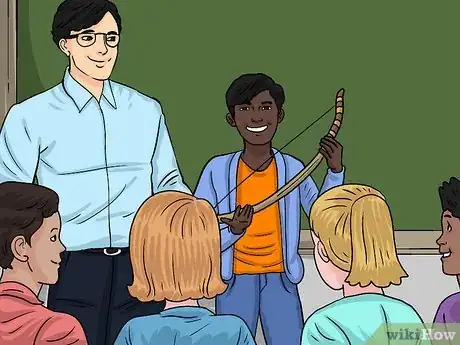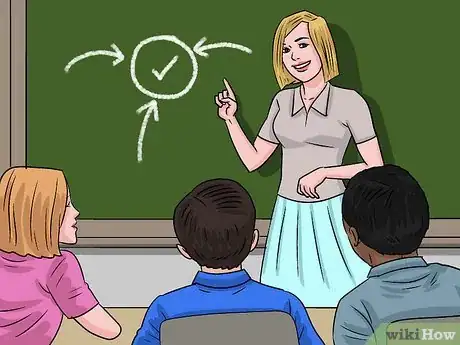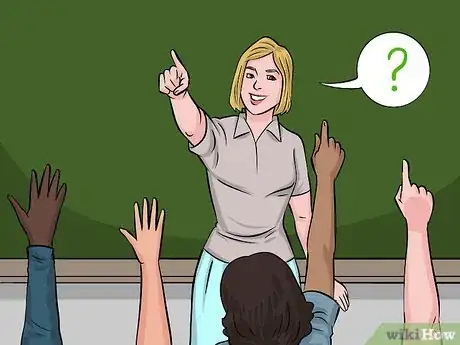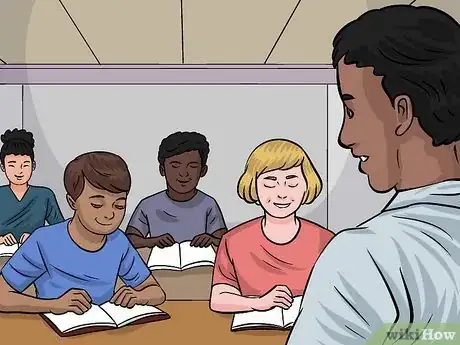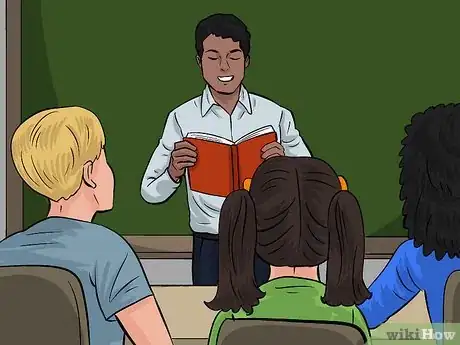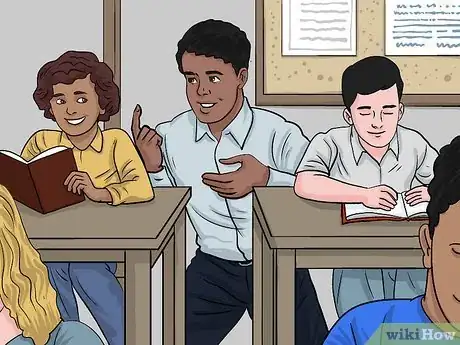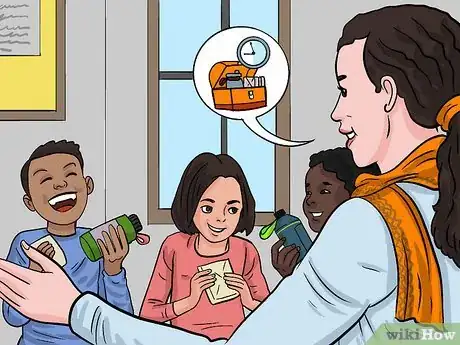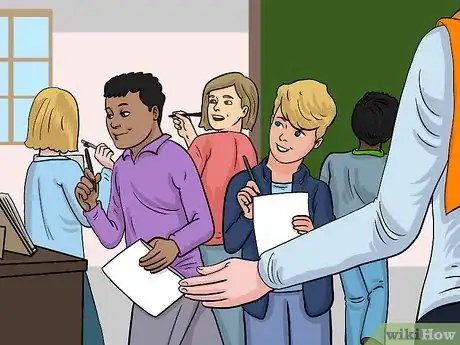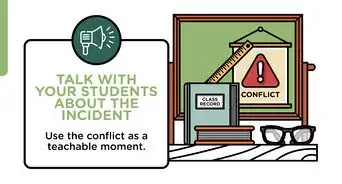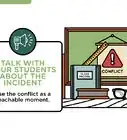wikiHow is a “wiki,” similar to Wikipedia, which means that many of our articles are co-written by multiple authors. To create this article, 22 people, some anonymous, worked to edit and improve it over time.
There are 10 references cited in this article, which can be found at the bottom of the page.
This article has been viewed 68,594 times.
Learn more...
Teaching 4th grade can be a very intimidating task. It is the year that most students begin standardized testing to gauge the school's effectiveness. It is one of the last years before students enter middle school. Here are some tips to help 4th grade teachers engage with their students and maximize their effectiveness at this crucial time in a child's education.
Steps
Creating a Comfortable Learning Environment
-
1Engage in conversations with students. Try to avoid lecturing to your students. They often have short attention spans and need a little help to remain in the present teaching moment. Encourage their input when you are teaching. This will help them participate more in their own education and will make them more confident about speaking up in class.
- Try to participate in conversations with your students even when you are not specifically teaching them. Allowing students to get to know you and showing them that you want to get to know them too makes them feel more comfortable in your class.
-
2Ask questions. Try to make your students think as much as possible. Ask them questions about their life; ask them questions about the world around them; ask them questions about the things you read in class. The more questions you ask, the more they'll be forced to think about the topic and come up with their own answers.Advertisement
-
3Be flexible. Different students learn in different ways. It's important to acknowledge this and to allow for a certain amount of flexibility in your daily schedule. If students are clearly interested in a certain topic, spend a little more time on it than you had initially planned. If an activity you planned isn't going over well, switch to something else. Always try to choose the option that keeps the students as engaged as possible. Unplanned active learning is better than forcing students into an activity that isn't holding their interest.
-
4Display student work. Students will be more engaged on a daily basis if they feel valued and rewarded. Make it a point to prominently display some of their artwork or other projects in your classroom so that they know you value what they do. This will help them feel proud of their accomplishments and want to continue the level of work that helped them get there.
-
5Consider special strategies for teaching various subjects. Each subject is different and requires different methods of teaching. The longer you teach 4th grade, the more you'll figure out what works for you. But here are a couple of tips dealing with various subjects:
- English. 4th grade English involves a lot of vocabulary and spelling practice, in addition to reading and writing. One of the best ways to help improve students vocabulary and spelling is through good old fashioned worksheets and spelling tests. Include educational games like role plays, crossword, jumbled words and other games to make the students happy and enthused to participate.[1]
- Social studies. A lot of what is learned in 4th grade social studies classes has to do with historical events, dates, people, and places. These topics can be hard to remember, so sometimes it can be helpful to show interesting educational videos that help students put a face with the name.
- Science. Science should be hands-on whenever possible to help students learn. Make students create a science project, make them draw out the phases of mitosis, or make them do anything else that gets them involved in the process.
Making Learning Fun
-
1Use games as a means of learning. Everyone gets bored eventually during lecture-style learning moments. And elementary school children have a much shorter attention span than most older students, so this is not an effective teaching method to employ with 4th graders. Try employing games in your classroom to boost students' energy levels and to improve their active involvement in the learning process.
- There are many examples of educational games that you can find on the internet. Find some that you think your students will be interested in and adapt them to your particular topic/subject if necessary. As you use the games in class, you'll figure out what works and what doesn't. Then you can adjust the activities for the next time so that they are better suited for your specific teaching style and subject matter. Here are some helpful websites that have in-class games appropriate for 4th grade students:
-
2Use rewards as incentives. Unfortunately, many 4th grade students have yet to discover the joy of learning for learning's sake. Try implementing a system of rewards that will motivate your students to stay on task and to complete projects satisfactorily.
- Note: Try to provide incentives for input activities (things that students put time into like reading and homework) rather than on output results (like grades and scores).[9] This will be more effective because students can control how much time they spend on activities, but they may struggle more with achieving certain grade levels. So if you assign incentives based on something students feel is largely out of their control, like what grade they get on a project or assignment, they may become flustered with the incentive program and give up trying to achieve the incentives altogether.
-
3Do a show and tell activity with your students. Most 4th grade students learn best by having hands on experience within the learning process. Ask your students to bring in an object they have in their house that relates to the topic you are currently studying. This will make them think about the subject matter and apply it to their own life in order to find a suitable item to bring to class.
- For example, if you're discussing Native American history, try to find an authentic arrowhead and show it to your class. Then ask your students to bring something from their own house that is related to Native American history in some way. They could bring a leather vest, a beaded purse, a toy horse, a picture of a hunting bow, or any other object related to the topic.
Providing Explicit Instructions
-
1Be direct. Make sure that you provide clear, direct instructions when you are assigning a certain task to students. Don't assume that they'll read between the lines or infer something that you don't explicitly state. Tell them exactly what you want them to do and how you expect them to do it.
-
2Show examples. Students can have many different learning styles. Some are visual learners, while others learn by doing. Whatever the case, you will have a variety of learning styles in your classroom and it is important to cater to them all. One of the easiest ways to do this is by showing examples to help your students practice whatever skill is being taught. Teaching them the skill, then showing them how to implement it is an effective way to make the skill stick.
- For example, if you are teaching your 4th grade students about multiplying fractions, it is important to teach them the problem solving method and then go over multiple examples with them. You can do this through worksheets in addition to problems on the board so that they have several ways to practice and learn the skill.
-
3Go over the directions twice. Sometimes kids don't understand the directions the first time around. And realistically, it's always possible that kids will become distracted and missed what you said the first time altogether. So, make sure they are paying attention and repeat the directions a second time.
-
4Allow your students time to ask questions. After giving your instructions, make sure that you provide enough time for your students to ask questions. That way, if something is unclear to them, they have time to ask for clarification.
Engaging Students with their Reading
-
1Go to the library. The library is a great place to help students develop an interest in reading and learning. Allow them several trips to the library every week so that they can pick out their books, return old books, and just spend some time reading.
-
2Provide ample in-class reading time. Let students have class time to just sit and read their books. You can decide if they have to read books just from the library or if they can bring books from home to read during this time. But the most important thing is to get students interested in reading and to give them time to do it in class. This will show them that reading is an important skill and will help them to develop stronger reading abilities over time.
-
3Read a book as a class. Reading a book as a class can be a fun experience that everyone looks forward to each day. The students can discuss the book with each other since they are all reading the same book at the same time. This will also help improve their listening comprehension skills because they are practicing listening to something that is fun and doesn't feel like work to them, but will still build these listening skills so they can apply it to their schoolwork.
-
4Make students practice. Studies have shown that children learn to read and write by reading and writing. So it is essential to give them time to practice these crucial skills in class and encourage them to reinforce these skills with homework and reading assignments.
Providing Structure through Class Routines
-
1Make a schedule and stick to it. Students thrive when they are given routines to follow. Knowing what they will do each day at a certain time allows them a sense of stability that helps them to feel more comfortable in your classroom.
-
2Consider pacing and stamina.[10] It is important to think about how long students can sit still, how long students should go between snacks, how long certain activities should take, etc. Planning too much of one activity can mean drastically decreased productivity. It is often helpful to schedule a short snack break or recess to break up longer periods of required concentration. If you keep these things in mind, you'll be better prepared to structure effective lessons that work to balance active participation with periods of sitting and listening.
-
3Schedule time for movement. Students need to be able to move around throughout the day. Getting their blood circulating with active movement can greatly increase their ability to concentrate and to stay energized as they work.
- Try building movement into your lessons. For example, structure your math lesson so that students must move from table to table to solve the problems.[11]
References
- ↑ http://www.jumpstart.com/teachers/curriculum/grade-based/4th-grade-curriculum
- ↑ http://www.learninggamesforkids.com/4th-grade-math.html
- ↑ http://www.funbrain.com/FBSearch.php?Grade=4
- ↑ http://www.abcya.com/fourth_grade_computers.htm
- ↑ http://www.knowledgeadventure.com/grade/4th-grade-games/
- ↑ http://www.education.com/activity/fourth-grade/
- ↑ http://www.vocabulary.co.il/fourth-grade-vocabulary-games/
- ↑ http://www.jumpstart.com/parents/activities/grade-based-activities/4th-grade-activities
- ↑ http://scholar.harvard.edu/files/fryer/files/092011_incentives_fryer_allen_paper2.pdf
